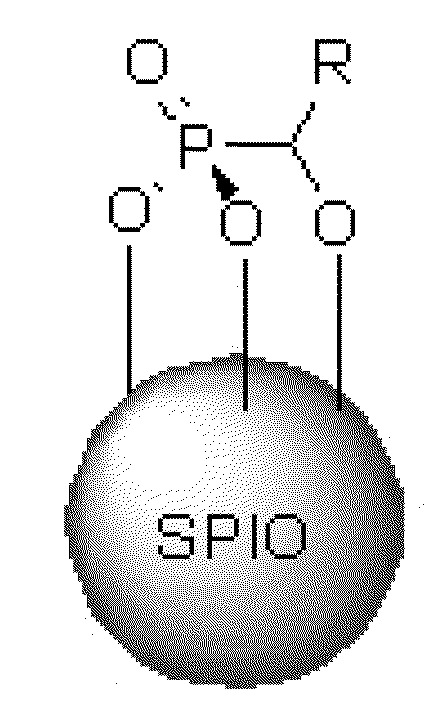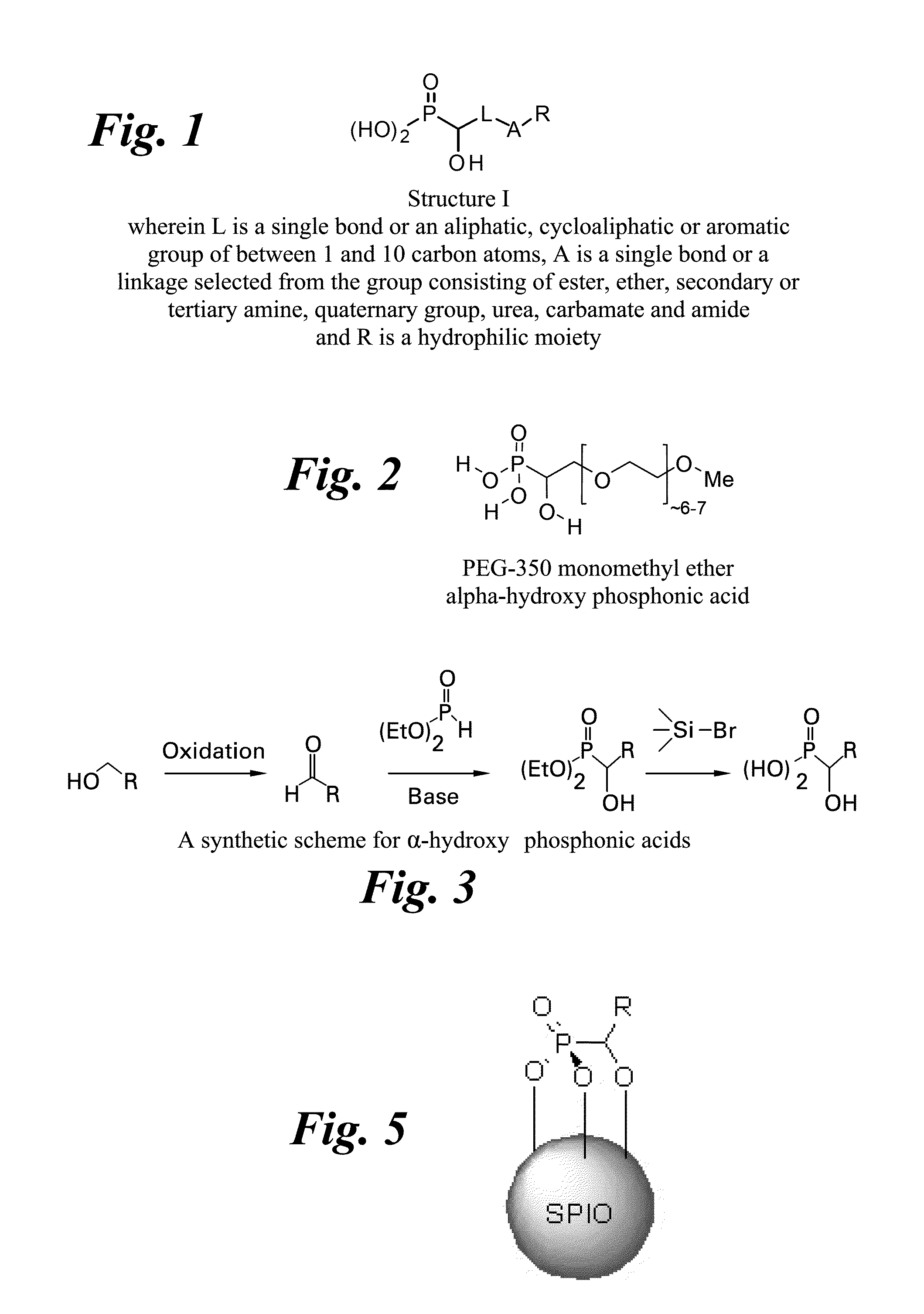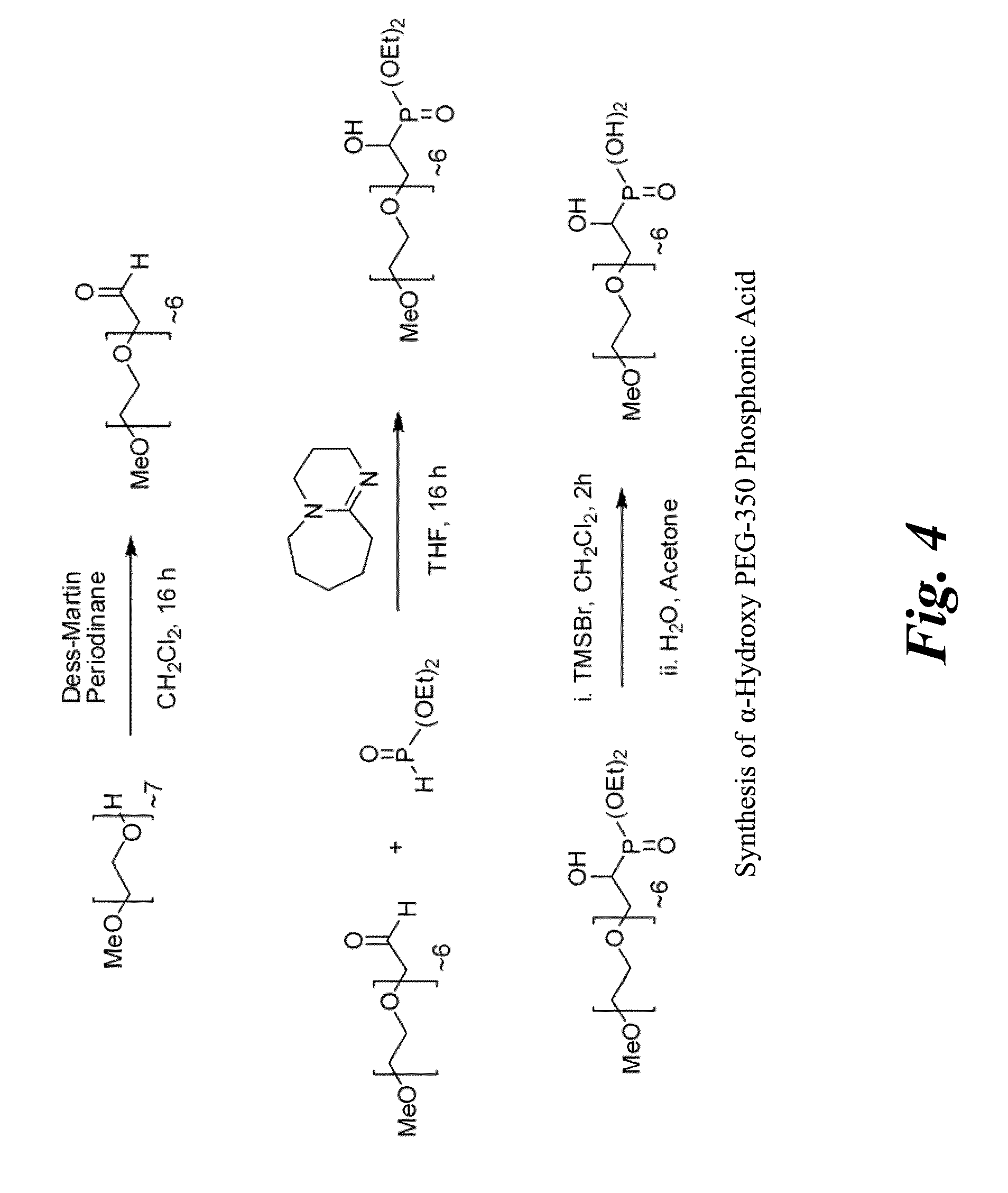Treating water insoluble nanoparticles with hydrophilic alpha-hydroxyphosphonic acid conjugates, the so modified nanoparticles and their use as contrast agents
- Summary
- Abstract
- Description
- Claims
- Application Information
AI Technical Summary
Benefits of technology
Problems solved by technology
Method used
Image
Examples
example 1
Synthesis of a PEG-350 Conjugate
[0046]Synthesis of PEG-350 mono(methyl ether) acetaldehyde. To a solution containing PEG-350 mono(methyl ether) (3.438 g, 9.82 mmol) dissolved in CH2Cl2 (98 mL) was added Dess-Martin Periodinane (5.00 g, 11.79 mmol) and the resulting solution was stirred at rt for 20 h. During the reaction a fine, white precipitate was formed and was removed at the end of the reaction via filtration through a celite pad. The solvent was removed from the filtrate in vacuo to leave a white solid suspended in a yellow oil. The solid was triturated with diethyl ether, and the solid was removed by filtration through a celite pad. Removal of the solvent from the filtrate in vacuo left the product PEG-350 mono(methyl ether) acetaldehyde (3.42 g, 100%) as a yellow oil. 1H NMR (CDCl3) δ 9.73 (t, J=4 Hz, 1H), 4.16 (d, J=4 Hz, 2H), 3.65 (m, 24H), 3.38 (s, 3H) ppm. IR (neat) 2873, 1732, 1455, 1350, 1109, 1040, 948, 851, 749 cm−1.
[0047]Synthesis of diethyl α-hydroxy PEG-350 mono(m...
example 2
Synthesis of a PEG-1900 Conjugate
[0049]Synthesis of PEG-1900 mono(methyl ether) acetaldehyde. To a solution containing PEG-1900 mono(methyl ether) (16.32 g, 8.60 mmol) dissolved in CH2Cl2 (86 mL) was added Dess-Martin Periodinane (4.00 g, 9.44 mmol) and the resulting solution was stirred at rt for 20 h. During the reaction a fine, white precipitate was formed and was removed at the end of the reaction via filtration through a celite pad. The solvent was removed from the filtrate in vacuo to leave a white solid which was recrystallized from THF / hexanes to give the desired product (11.6 g, 71%) as a white solid. 1H NMR (CDCl3) δ 9.74 (t, J=1 Hz, 1H), 4.17 (d, J=1 Hz 2H), 3.83 (m, 2H), 3.65 (m, 170H), 3.39 (s, 3H).
[0050]Synthesis of diethyl α-hydroxy PEG-1900 mono(methyl ether) phosphonate. To a solution containing PEG-1900 mono(methyl ether) acetaldehyde (10.74 g, 5.66 mmol) dissolved in tetrahydrofuran (57 mL) was added diethyl phosphite (0.938 g, 6.79 mmol) followed by 1,8-diazabicy...
example 3
[0054]Synthesis of superparamagnetic iron oxide (SPIO) nanoparticles. A 100 mL three-necked round bottom flask was charged with Fe(acac)3 (0.706 g, 2.0 mmol) and anhydrous benzyl alcohol (20 mL). The resulting solution was sparged with nitrogen and heated to 165° C. for 4 hours under a nitrogen atmosphere. The resulting colloidal suspension of 5 nm iron oxide particles (As determined by DLS) was then cooled to, and stored, at room temperature.
PUM
| Property | Measurement | Unit |
|---|---|---|
| Time | aaaaa | aaaaa |
| Mass | aaaaa | aaaaa |
| Mass | aaaaa | aaaaa |
Abstract
Description
Claims
Application Information
 Login to View More
Login to View More - R&D
- Intellectual Property
- Life Sciences
- Materials
- Tech Scout
- Unparalleled Data Quality
- Higher Quality Content
- 60% Fewer Hallucinations
Browse by: Latest US Patents, China's latest patents, Technical Efficacy Thesaurus, Application Domain, Technology Topic, Popular Technical Reports.
© 2025 PatSnap. All rights reserved.Legal|Privacy policy|Modern Slavery Act Transparency Statement|Sitemap|About US| Contact US: help@patsnap.com



